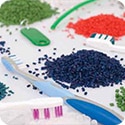Access Agilent eNewsletter, April 2014
>> Update My Profile | Subscribe to Access Agilent | Article Directory

Ask the Expert: I’ve been using LC for years.
What’s different about GPC/SEC and what steps should I take to ensure my success?
By Stephen Luke
Agilent Product Manager – GPC
Gel permeation chromatography (GPC) and size exclusion chromatography (SEC) are the most popular techniques for measuring the molecular weight distribution of natural and synthetic polymers, a property that affects many of the physical parameters of materials, such as strength, toughness and chemical resistance. GPC and SEC are types of liquid chromatography (LC), and both solid stationary and liquid mobile phases are used. However, the separation mechanism here relies solely on the size of polymer molecules in solution, rather than any chemical interactions between particles and the stationary phase.
GPC is used to describe the analysis of polymers in organic solvents, such as tetrahydrofuran, while SEC is for the analysis of polymers in water and water-based solvents, such as buffer solutions. GPC and SEC are the only established methods for obtaining a comprehensive understanding of a polymer’s molecular weight distribution.
Being familiar with LC helps, but if you are new to GPC or SEC, there are several points to consider when setting up a GPC system.
Choose the proper eluent based on your sample’s solvent
You first need to know what dissolves your sample in order to choose an eluent. This is key when developing methods for analyzing polymers, because many polymers are only soluble in a small number of solvents. Common eluents include water or water/buffer with up to 50% methanol, 100% organics such as tetrahydrofuran, chloroform, toluene, and polar organics such as dimethylformamide or N-methyl-2-pyrrolidone.
Polymer type |
Typical molecular weight |
|---|---|
Polymers from free radical synthesis |
High, intermediate |
Polymers from ionic and addition synthesis |
Intermediate, low |
Polymers from controlled radical polymerization |
Low, very low |
Polyolefins |
High, intermediate |
Acrylates |
High, intermediate |
Small molecule additives |
Very low |
Pre-polymers |
Low, very low |
Resins |
Low, very low |
Natural biopolymers such as polysaccharides |
High, intermediate |
Rubbers |
High, intermediate |
Biodegradable polymers |
Intermediate, low |
Table 1. Molecular weight ranges of some common polymers.
Choose your column based on the molecular weight range of your sample
To select the optimum column, it helps if you know the expected molecular weight range of your sample, whether high (up to several millions), intermediate (up to hundreds of thousands), low (up to tens of thousands), or very low (a few thousand). If you don’t know the molecular weight then start with an Agilent PL aquagel-OH MIXED-M column for aqueous solvents, an Agilent PLgel MIXED-C for organics, or an Agilent PolarGel M for mixed solvents. Table 1 shows some approximate molecular weight ranges for common polymers, which will help you select the right column for your sample if you don’t know its molecular weight range.
Choose the number of columns you’ll use based on particle size
Particle size should guide the number of columns you use. The larger the particle size of the media in the column (which is dependent on the expected molecular weight of the samples), the lower the resolution and the more columns are required to maintain the quality of the results. For higher molecular weight samples, larger particles are necessary to reduce the danger of shear degradation of samples during analysis, so use four columns for 20 µm particles, three columns for 10 or 13 µm particles, and one or two columns for 3, 5, or 8 µm particles.
Column particle size also determines injection volume
The injection volume also depends on the particle size of the column – smaller particles need lower injection volumes to minimize dead volumes. Larger injection volumes allow the introduction of high molecular weight samples at lower concentrations, reducing viscosity and ensuring the quality of your results. Inject 200 µL for particles of 10, 13, and 20 µm, 100 or 200 µL for 10 and 20 µm particles, and 20 µL for 3 µm particles.
Choose column calibration standards based on your eluent
Your choice of column calibration standards depends on the eluent, since standards are polymers. For water or water/buffer with up to 50% methanol we recommend polyethylene glycol/oxide, for THF, chloroform, and toluene use polystyrene, and for organic/water mixes or polar organics use PEG/PEO.
Use an Agilent organic or aqueous startup kit for added confidence
If you are new to GPC/SEC, Agilent’s organic and aqueous startup kits for GPC/SEC are the easy way to get up and running with confidence. Each kit contains a column, test certificate, calibration standards, test sample, characterization data, and full instructions. To explore GPC techniques in more detail, Agilent offers a comprehensive portfolio of GPC/SEC instruments, columns, and calibrants for high performance separations based on molecular size in solution.
Take full advantage of our comprehensive online information
You also have free access to our full range of supporting information, including application compendia, primers, and selection guides.
>> Update My Profile | Subscribe to Access Agilent | Article Directory